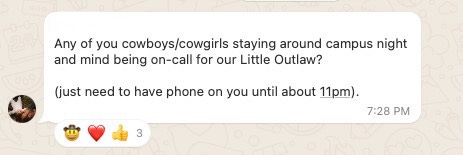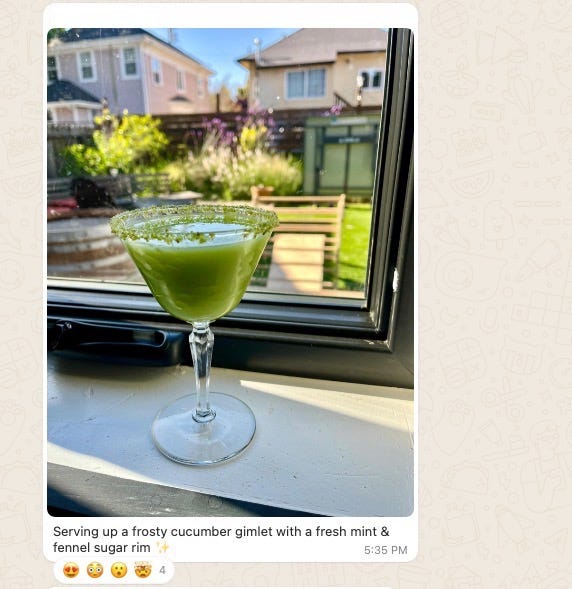With friendship, more is more (pt 1)
how are we meant to be living? near lots of other people
Covid forced me to reckon with loneliness that had already been percolating for a few years. Stuck inside, I developed the habit of charting friends onto scribbly maps drawn on post-its and back pages of notebooks. I’d scrawl names over New York, London, Seattle, LA, the Bay Area. The fact that I sometimes forgot a few people reinforced to me the very importance of the exercise. My friendships felt like marbles, loose and slippery in my hands. I really, really didn’t want to lose any. I worried that would mean losing parts of myself.
These scribbled maps were an act of self-soothing, helping me hold in my mind that all these people were still real even if I hadn’t seen many of them in years. They were also an attempt to convince myself that the Bay Area, my home for the last decade, was the right place for me and my now-husband to double down. The facts were right there on the page: we had more friends in the Bay than anywhere else. But still, a voice in my head would whisper, “Is it really about more friends? Isn’t it about best friends?” We spent many nights weighing the pros and cons of different cities—both the people and the places.
Then two years ago, an apartment became available at Radish, a mini neighborhood made up of 20 friends (and friends-of-friends) on a single block. My husband and I thought it sounded like a pretty lovely experiment to run on our lives, and at the end of that summer we moved in.
We have our own pretty typical two-bedroom apartment. But we gather as a group of 10+ for dinner on most weekdays. We hang out in a shared backyard, have a WhatsApp group for “Hey, does anybody…?” questions, and just generally have each other’s backs.
I’m now convinced the solution for the sort of pervasive, low-grade loneliness that I used to feel isn’t more of what we’re all already doing: more dinners planned three weeks out, more coffee catchups, more vulnerable posts on Instagram, more Sunday FaceTimes with long-distance friends. That’s more work, and in the current state of things, we’re already overworked.
I think we need more effortless day-to-day closeness with people. And the best way to achieve that is to live near each other.
Invest in the people who love the same place that you do.
The same system that has given us a lot of freedom (knowledge work, WFH, opportunities to live places far from our hometowns) came at a cost. Too many options created geographic restlessness. There’s always someplace else where our lives might be even better.
I will always cherish my close friends spread all around the world. But now that I live near so many people, my longing for them to fulfill my need for day-to-day closeness has waned. The feeling of unease that used to come over me after getting off the phone with a long-distance friend—the little voice in my head questioning why I wasn’t actively re-orienting my life to be closer to them—has lifted. My location FOMO has gone down a lot.
The truth is, I love the Bay Area for many reasons beyond the people. It made sense for me to invest in people who also like this place, and to grow those relationships.
I think it’s worth communicating feelings of commitment to a place. I think you should ask your friends where they’d like to raise their kids. I think it’s worthwhile and also very endearing to campaign your friends to stay put, to tell them: “My life is so much better with you in it, and I would be really sad if you left.” They may still leave! Nothing is guaranteed. But I’m attracted to the gravity that others create when they are confident about where they want to be. I want to offer that kind of gravity myself.
Consider how friendly connections can be as important as close friendships.
My husband and I had two close friends on the super block where we now live, but we didn't know everyone before we moved in. We’ve grown closer with people as we’ve gotten to know their daily rhythms, senses of humor, and the ways they like to be helpful. But even now, two years later, we don’t necessarily have a deep one-on-one relationship with every single person. If I grabbed a coffee with each of my neighbors on rotation, I’d be going on 20 coffee dates a month!
And yet, living near so many lovely people has deepened my sense of belonging in a really material way. Every neighbor’s house visible from my kitchen window is owned or rented by someone that I know. It’s a village, and I’m a part of that village. I didn’t realize how much I longed for something like that until I had it.
Living close to people brings a lot of ease without a lot of effort. I don’t have to run to CVS if I cut my finger because a neighbor will come deliver me a bandaid. It’s painless to keep an eye on my friends’ baby monitor while I watch Fleabag for the third time so that they can go on a date. Sometimes when I’m grumpy and begrudgingly give a friendly wave from my stoop, it’ll turn into a little chitchat that actually makes me feel better. A trick like that might not even work with someone like my best friend or partner, whom I’d be less likely to shield from a bad mood.
Sometimes people ask if I wish that Radish was with all of my “best friends.” And the complicated answer is that I’m not sure. Yes, of course? But also no, because part of the magic is that it’s filled with people who are similarly bought in on the benefits. If for you that’s your best friends—amazing! But should you let your desire for an even-better fantasy ruin a great option you have right in front of you with newer friends, or a sweet couple who are on the same kid timeline? I don’t think so.
If I were starting from scratch, I’d start small. Start conversations with the people next door. If they’re friendly and reasonable, bring them over something you bake, or offer to take in their mail or water their plants the next time they’re traveling. Do just a little more than feels natural. Don’t assume that they’ll do any work for the relationship until you model for them how reciprocity could happen. See what develops!
If you meet a really cool new couple and they express interest in moving to your neighborhood—invite them to dinner and encourage them! Maybe they’ll become a much bigger part of your life. If a few friends have kids the same age, start a conversation about becoming neighbors. Live Near Friends is a social real estate tool that can help with that.
And if friends of those friends eventually also want to move nearby—even if you don’t know them well yourselves—stay open-minded to the “moreness” that development could introduce into your life.
Don’t let the perfect ruin the good.
Logan Ury, the author of the book How To Not Die Alone (and also one of my neighbors) wrote about a concept she calls “Maximizers.” These are the people who want to be 100% sure they’ve made the right decision about a romantic partner, and who are terrified that they might accidentally settle.
I think the concept of maximizers applies to a lot more than dating. But whether you’re trying to maximize the place you live, or the exact people you live near, I’m convinced that holding out for perfection robs you of a lot of beauty. And I'm here for the beauty.
Living at Radish meant moving 30 minutes away from my beloved neighborhood (and a coffee shop where everybody knew my name). And it might sound silly, but it also meant getting over the fact that our new house wasn’t as pretty as our old place. My husband and I decided that the intangible benefits (Fun! Serendipity! Support! Learning from new parents!) would probably outweigh the more tangible downsides (A neighborhood that we like less, less control, less privacy). And aren’t so many big decisions like that? He and I still marvel at how dramatically the intangibles outweigh the tangibles.
I wonder if we’re all much too afraid that having people around will mean we’re irked all the time. We’re concerned that small irritations will pile up, and maybe even snowball into insurmountable conflict. I think that most of us are out of practice with encountering even minor annoyances and inconveniences outside of the ones we very willingly tolerate with our partners, kids, or parents. But by presuming that nothing is worth messing up our perfect setups, we box ourselves into a reality that’s very sanitized—and pretty lonely.
On a recent Ezra Klein podcast episode he quoted Zarinah Agnew, who said she had decided to “choose the problems of community as opposed to the problems of not having community.” Maybe—and I might be speaking to myself here—a bigger, fuller, more populated life is a daily reminder that perfection was the wrong goal all along.









this is fascinating! thanks for sharing :) Radish sounds like the neighbourhood I've been looking for - I love the point on the minor inconveniences being worth it compared to the sanitized comfort. I have a few questions:
1. what seems like the ideal size for a commune?
2. do most people living in radish work remotely?
3. what are your thoughts on mixing extended family and friends within a commune? can that work well?